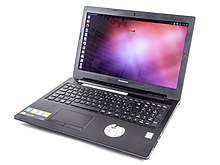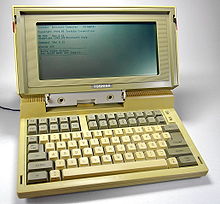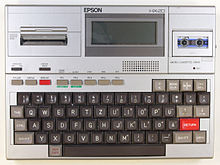Laptop
A notebook [ˈnəʊtbʊk] (English notebook 'notebook') or laptop [ˈlæpˌtɔp] ![]() (from English 'laptop' literally for "on the lap", rendered "lap calculator"), rarely also folding calculator, is a special design of personal computer that belongs to the mobile devices. It has the following basic features:
(from English 'laptop' literally for "on the lap", rendered "lap calculator"), rarely also folding calculator, is a special design of personal computer that belongs to the mobile devices. It has the following basic features:
- A keyboard is integrated flush with the upper surface of a flat rectangular housing. In the alphanumeric area, this usually has the key center distance of 19 mm required by ISO 9241-410:2012-12 for efficient typing and has a keyboard layout in accordance with ISO/IEC 9995-2, e.g. QWERTZ for the German-speaking area of application.
- A similarly large screen is movably attached to this housing, which can be folded onto the housing in such a way that, when closed, the screen surface and keyboard are on the inside, thus making the entire device transportable without any special protection requirements. The joints hold the unfolded screen in any position by static friction without further mechanical support; the entire device always remains tilt-proof, since the weight-intensive components are arranged together with the keyboard in the base housing.
- The device can be used independent of location. The power supply is provided by accumulators.
In terms of size and performance, notebooks fall between the larger desktop computers and the smaller tablets by today's standards. In the 2010s, notebooks have come close in terms of performance to the classic desktop computers and have taken market share from them.

Lenovo ThinkPad G500s (2013)
Term
Conceptual History
At the end of the 1980s, Toshiba introduced the term notebook in order to better market particularly compact and light (like a notebook) devices. In the meantime, the terms notebook and laptop are largely used synonymously in the German-speaking world, although the term notebook tends to be used for the mid-size versions. Laptop (der, auch das) refers to the fact that the mobile computer fits on the lap.
In the English-speaking world, the term laptop is common; notebook and also notebook computer are also used.
At the beginning of the 2000s, the term Klapprechner (folding computer) also appeared in the German-speaking world and is also used as an example in linguistic texts. Efforts to use this term to displace the anglicisms "notebook" and "laptop" can now be considered unsuccessful. Nevertheless, the Verein Deutsche Sprache e. V. awarded its negative prize "Language Prankster of the Year 2013" to "the Duden" with explicit reference in the justification to the fact that the word "Klapprechner" is not listed in its current edition.
Distinction from other terms
The term netbook has been used since 2007 for a significantly smaller device without an optical drive, whose keys can also be too small for use in the ten-finger system. Since about 2011, the term is hardly used anymore, tablets or convertibles replaced netbooks.
The term portable usually refers to a device with the technology and dimensions of a desktop computer, but whose usually case-shaped housing is designed for regular transport and in which a screen is usually integrated immovably (especially with older devices with picture tubes). Unlike notebooks, such devices usually rely on external power supply and do not necessarily have a keyboard permanently attached to the device. Due to their size, mostly for desktop computers can be installed certain expansion cards of the formats common at the time of production. Computers of this type have been used since the mid-2010s only for special applications (e.g. military) where notebooks cannot be used.
The term mobile computer generally refers to a portable computer intended for use at different locations.
In German colloquial language, the term Schlepptop (drag top) was used for a time. This may have originated in the early days of mobile portable computers, which looked like suitcases and weighed about ten kilograms, such as the Osborne 1 in 1981, the Portable 8810/25 from Nixdorf Computer AG in 1985 (costing about 8000 DM) or the Kaypro II.

With the T1100 Toshiba introduced the name notebook in Germany in 1987

Laptop with removable keyboard (1990)
History
The Dynabook is a concept designed by Alan Kay at Xerox PARC in 1972. It features a flat rectangular case with both screen and keyboard integrated in the same plane. Thus, the basic ideas of both the laptop (only without the foldable screen) and the tablet computer are formulated in it. Due to the lack of technical possibilities at the time, the concept was not implemented.
One of the first computers to be described as a laptop is the GRiD Compass 1100, which was designed by the British industrial designer Bill Moggridge in 1979, but was not sold for the first time until 1982. Although this laptop had a considerable 340 kB of main memory at the time, it did not enjoy commercial success due to its lack of IBM compatibility.
In 1986, one year after the Toshiba T1100, the IBM PC Convertible appeared, the first commercially successful notebook with a clock frequency of 4.77 MHz, two 3.5-inch floppy drives, 256 kB memory, an LC screen and printer connections. In 1987, the Toshiba T1100 with two 3.5-inch floppy drives and an LCD screen still cost around 3700 Swiss francs in Switzerland, while the T3100 with a plasma screen, 640 kB of memory and a hard disk of 10 megabytes cost twice as much.
The first notebook with today's controls was the PowerBook 100 from Apple. For the first time, the user could do without external input devices because the PowerBook had a trackball as well as hand rests on the side. The terms notebook and laptop have now merged and are used equally. The first laptop to be officially called this was the Gavilan SC, which was released in 1983 and strongly resembled a typewriter.
Until the 1990s, almost every notebook had a floppy disk drive. These fell into disuse due to the low storage capacity of approx. 1.4 MB and the advent of USB sticks. For similar reasons, optical drives have hardly been installed in notebooks since the mid-2010s.

The 1982 Epson HX-20, a battery-powered handheld computer with tape drive, LCD, built-in BASIC and printer, is considered one of the first notebooks.
Questions and Answers
Q: What is a laptop?
A: A laptop is a portable computer that is easy to carry around.
Q: What components does a modern laptop typically have?
A: A modern laptop typically has a screen, keyboard, touchpad, speakers, microphone, and a camera.
Q: How is a laptop powered?
A: A laptop is powered by a built-in rechargeable battery, but it can also be plugged in to use and recharge the battery at the same time.
Q: What external devices can usually be attached to a laptop?
A: Most other external devices can be attached to a laptop if required.
Q: How can a laptop be carried?
A: The laptop screen folds down over the keyboard, along a hinge, for carrying.
Q: What are some advantages of laptops over desktop computers?
A: Advantages of laptops over desktop computers include that they can be carried anywhere, have a built-in webcam, microphone and speakers that make video calls easier, can be used in smaller spaces, and can easily be locked away securely, making them harder to steal.
Q: What are some disadvantages of portable computers?
A: The given text does not provide any further information about the disadvantages of portable computers.
Search within the encyclopedia